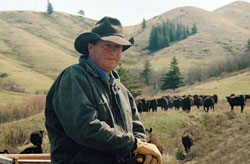Coloured Horses and Black Cattle
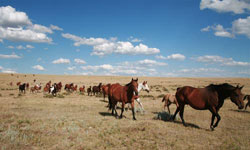 |
|
Photo by Gary Houston |
In 1899, Everett and Bethea Parsonage and their seven children, enroute from Pilot Mound, Manitoba to Pincher Creek, Alberta, camped in the Cypress Hills long enough to have a baby – and they never left. Four more babies and over one hundred years later, the Saskatchewan Brand Book has twenty-two cattle brands and eight horse brands registered under the Parsonage name.
Everett was seven when he and his family left their Ilford home near London, England, and settled in Minden, Ontario, Haliburton County. By 1875, at age twenty, he was an experienced hunter, woodsman and oarsman, skills that served him well when he was hired to guide a community of Icelanders along the Red River to Lake Winnipeg, eventually reaching Gimli, Manitoba, where they survived a brutal winter.
In 1878 he took out a homestead at Pilot Mound and five years later he married Bethea Blackburn. In 1898, he and his family and brother, Fred, loaded their buggy and two covered wagons then headed west with their small herd of horses and fifteen purebred Shorthorn cattle. They milked cows along the way and Bethea baked bread over campfire coals in the evening. So it was they ended up in the Cypress Hills in time for baby Marion to be born, with her older sisters acting as midwives.
Everett filed on a homestead along Battle Creek four miles south of the abandoned (later rebuilt) Fort Walsh. Since it was already August, the pressure was on to get logs hauled, a house, barn and
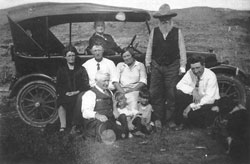 |
|
Photo courtesy of Parsonage family collection |
corrals built and hay cut and stacked before winter. Bethea named the ranch, Roseburn Ranch, Scottish for “roses on the creek.”
Everett and his older boys herded bulls on the unfenced Middle Fork open range in May and June, sometimes as many as two hundred. They lived in tents and often cooked eggs gathered from coot and duck nests. The buffalo were gone and other game was scarce. On one occasion a mounted policeman stopped for dinner at their home. As he was leaving he noticed the dog chewing on a slim antelope shank and commented, “That’s darn fine beef you people are eating, but for God’s sake don’t leave those shanks lying around.”
Everett trapped mink and bobcats on Battle Creek and fished for suckers. To make an extra dollar he cut hay for the police at the Ten Mile Detachment. He also delivered mail to post offices at Battle Creek, Coulee, Cypress and Maple Creek (forty miles away), making the return trip the next day.
Everett and Bethea’s youngest son, Graham married Laura Wilkes of the Oxarat district in 1936 and took over the home ranch when poor health forced Everett and Bethea’s move to town. In those early winters, stocking up on basic food staples was a necessity as it could be four months before they visited town. Graham, like his father, was a stockman, trapper and hunter. Laura, ninety-three, who now lives in Maple Creek, recalls, “When Graham and I were first married, it was furs that put the grub on the table. When he was eighty-one, Graham shot twenty-five coyotes, trapped two mink and a couple of badgers.”
Graham, Laura and their three children: Bertha, Wilkes, and Roger, spent many enjoyable
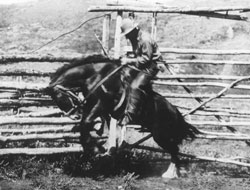 |
|
Photo courtesy of Parsonage family collection |
Sunday outings hunting for native artifacts. They travelled as far north as the Great Sand Hills gathering arrowheads, scrapers and spears. Buying antiques at auction sales was another passion with each piece linked to pioneer history.
Bertha Wakely (Garry) was a nurse and poet. Wilkes and Joan (Pickett) ranch nearby and Roger and his wife Lou (Davies) are on the original homestead. In 1949 Graham and Laura built a new home using some logs salvaged from Fort Walsh buildings. Restoration of the original log house began in 1964 when the sod roof started to fall in. The challenge was to get a cement foundation underneath, remove old chinking, redo it, and build a new roof.
When “The Canadians” was filmed in the area in 1960, Graham and neighbouring ranchers participated by supplying horses, working as wranglers and dressing as natives. Graham’s horses wore the original Parsonage horse brand – P7 on the left shoulder – still used today.
Graham, Laura and their three children: Bertha, Wilkes, and Roger, spent many enjoyable Sunday outings hunting for native artifacts. They travelled as far north as the Great Sand Hills gathering arrowheads, scrapers and spears. Buying antiques at auction sales was another passion with each piece linked to pioneer history.
Bertha Wakely (Garry) was a nurse and poet. Wilkes and Joan (Pickett) ranch nearby and Roger and his wife Lou (Davies) are on the original homestead. In 1949 Graham and Laura built a new home using some logs salvaged from Fort Walsh buildings. Restoration of the original log house began in 1964 when the sod roof started to fall in. The challenge was to get a cement foundation underneath, remove old chinking, redo it, and build a new roof.
When “The Canadians” was filmed in the area in 1960, Graham and neighbouring ranchers participated by supplying horses, working as wranglers and dressing as natives. Graham’s horses wore the original Parsonage horse brand – P7 on the left shoulder – still used today.
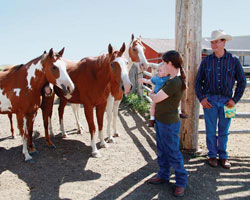 |
|
Photo by Gary Houston |
The following year, the “Sagebrush Boys” band, Wilkes and Roger along with James Anderson and Ronnie Johnson, won the Talent Night at nearby Robsart. Rick Jones later joined, and with help from a few others over the years, the band has kept a lot of toes tapping. “As well as their music,” Laura reminisces, “Wilkes was always a hunter and trapper. With Roger it was always horses. Riding the school bus bothered his hips and back but bronc riding never did.”
Music and art go hand in hand in the Parsonage family. Laura has a one-of-a-kind collection of Indian and Eskimo dolls she has made. Many include a piece of her written history. “I love to do the faces and give them different expressions.” Also, paying great attention to detail, she has molded dinosaurs from paper-mâché, shaped prehistoric birds from juniper root and used her taxidermy skills to preserve a cedar waxwing.
Roger and his friend, the late Raymond Beierbach, once visited Jerry Symons (son of author/artist R. D. Symons), in South America. They had thought of ranching there but some Columbians’ limited respect for human life changed their minds. Lined muleskin chaps, a braided reata and stirrups big enough for two toes (Columbians ride barefoot) are among Roger’s souvenirs.
Living so far from town has made the Parsonages innovative and self-sufficient. As a teen, Roger purchased a leather sewing machine, which proved invaluable for making and repairing horse gear for himself and his neighbours. They run a cow/calf outfit, winter their calves and then grass
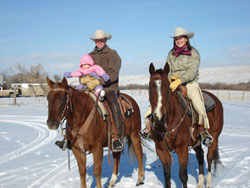 |
|
Photo by Micky Kusler |
them. The addition of a weigh scale has meant yearlings are weighed and a price negotiated before cattle leave the yard. Roger says, “Two of the things I like best about ranching these past few years are round bales and black cattle.”
When you step inside Roger and Lou’s home, once the Credit Union building in Maple Creek, you immediately feel comfortable. The walls surround you with western art. An oak coffee table, designed and built by their son, Chuck, has a glass top and a pullout drawer that holds Roger’s collection of buckles and spurs. Each spur has serial number 48, the year Roger was born; the buckles he won at ropings and ranch rodeos.
In June, 1968, the remount station at Fort Walsh was moved to Pakenham, Ontario and the 20-year-old stallion, Faux Pas, who had won the Gold Cup of Ascot and who was sire to all the horses in the 1968 RCMP Musical Ride, was entrusted to Roger. Faux Pas gave the Parsonages and their neighbors many great colts. Roger particularly remembers Josh, “a hell of a horse.”
Roger was astride another of his favourite horses, his Rucker stud, when Arnold Mackie, Brett Gaff, Carl Parsonage (Wilkes’ son), Roger and his son, Chuck, won Maple Creek’s first Ranch Rodeo in 1988. Two years later they were repeat winners with Roger’s younger son, Jess, a team member.
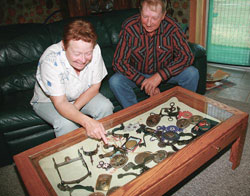 |
|
Photo by Gary Houston |
For seventeen years Roger was roundup boss for the Cypress Hills Stockmen’s Association. People that ride the roundup say the boss has to be able to get along with good hands, greenhorns, kids and anyone else along for the ride and he must know the West Block, the horses and the cattle. Roger modestly says it wasn’t a hard job. “Them guys do what they want anyway.”
Whether it’s about horse trading, horse training or horse trailering, Roger’s eyes light up with the telling. He says they try to raise horses that will last, horses that people can get along with. “I’ve always liked coloured horses.” They sell quarter horses and paints and belonged to the Cypress Hills Registered Horse Breeders for twenty-eight years, but now offer their colts through the Ranch Country Horse Sale.
Roger and Lou have two sons: Chuck and Kyley (Peterson) ranch with Roger and Lou; Jess and Tanya (Winskowski) are ranching on their own. Roger and Lou’s two young granddaughters, Louise and Olivia, have been born into a family where the women work with cattle, ride with men and live close to the land.
It’s a stark and beautiful land. A rutted trail winds along a mesa overlooking Battle Creek and the Parsonage ranch. The creek, tranquil now, can be a raging giant during spring flood. At a gate, three young curlews sneak through the grass. Horses stand on a hill with a backdrop of bluebird sky and a scattering of flat-bottomed clouds. The new stallion, Chex My Magic, and his band of mares with colts frolicking at their sides, trot toward us. There are red and blue roans, buckskins, paints, blacks and bays. I’m reminded of Lou’s words, “We’re always trying to improve our cow herd – our living; but horses, family and friends are our life.”
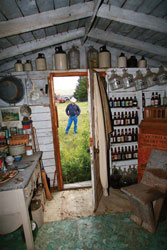 |
Photo by Gary Houston |
|
|
“When neighbours ask Roger to heel at their brandings, it’s a treat to watch his cowboy skills. He’s just as liable to rope a calf from the left side with a backhand as he is to use a standard heel loop to catch one from the right side. He simply takes what the calf offers.” |
Doris Bircham ranches with her family in the Cypress Hills area of southwestern Saskatchewan. She has just published a new book of poetry, Where the Blue Grama Grows, available through Hagios Press.

